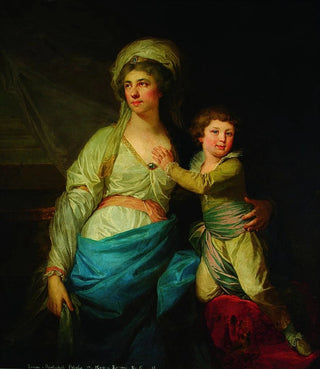Art print | Portrait of Teresa Potocka née Ossolińska with Uncle Alfred - Johann Baptist von Lampi the Elder


View from behind

Frame (optional)
In the vast panorama of art history, certain works stand out for their ability to capture the essence of a period and a personality. The art print of Teresa Potocka, née Ossolińska, accompanied by her uncle Alfred, created by Johann Baptist von Lampi the Elder, is one of these iconic pieces. This representation, imbued with delicacy and depth, invites us to delve into the aristocratic universe of the 18th century, where art and social life intertwine. Teresa's gaze, both contemplative and confident, seems to tell us a story—one of a woman who is both strong and vulnerable, evolving in a world governed by strict conventions. This art print does not merely freeze a moment; it evokes an atmosphere, a period, and above all, a personality.
Style and uniqueness of the work
Johann Baptist von Lampi the Elder's style is characterized by remarkable finesse and meticulous attention to detail. In this art print, he manages to balance the rigor of composition with striking expressiveness. The drapery of Teresa's dress, rendered with vibrant realism, almost feels tangible, while the nuances of colors chosen by the artist breathe vibrant life into the entire piece. The subtly orchestrated lighting highlights the delicate features of her face, emphasizing her gaze—both melancholic and determined. This art print transcends a simple portrait to become a true psychological study, where each element contributes to narrating Teresa's identity. The presence of her uncle Alfred, though secondary, adds a familial and social dimension, reinforcing the idea that this art print is as much an individual representation as a reflection of the interpersonal relationships of the period.
The artist and his influence
Johann Baptist von Lampi the Elder, born in 1751, established himself in the European artistic scene thanks to his talent and sensitivity. Trained at the Vienna Academy of Fine Arts, he developed a style that combines classicism with touches of romanticism, thus prefiguring subsequent artistic currents.

Matte finish

View from behind

Frame (optional)
In the vast panorama of art history, certain works stand out for their ability to capture the essence of a period and a personality. The art print of Teresa Potocka, née Ossolińska, accompanied by her uncle Alfred, created by Johann Baptist von Lampi the Elder, is one of these iconic pieces. This representation, imbued with delicacy and depth, invites us to delve into the aristocratic universe of the 18th century, where art and social life intertwine. Teresa's gaze, both contemplative and confident, seems to tell us a story—one of a woman who is both strong and vulnerable, evolving in a world governed by strict conventions. This art print does not merely freeze a moment; it evokes an atmosphere, a period, and above all, a personality.
Style and uniqueness of the work
Johann Baptist von Lampi the Elder's style is characterized by remarkable finesse and meticulous attention to detail. In this art print, he manages to balance the rigor of composition with striking expressiveness. The drapery of Teresa's dress, rendered with vibrant realism, almost feels tangible, while the nuances of colors chosen by the artist breathe vibrant life into the entire piece. The subtly orchestrated lighting highlights the delicate features of her face, emphasizing her gaze—both melancholic and determined. This art print transcends a simple portrait to become a true psychological study, where each element contributes to narrating Teresa's identity. The presence of her uncle Alfred, though secondary, adds a familial and social dimension, reinforcing the idea that this art print is as much an individual representation as a reflection of the interpersonal relationships of the period.
The artist and his influence
Johann Baptist von Lampi the Elder, born in 1751, established himself in the European artistic scene thanks to his talent and sensitivity. Trained at the Vienna Academy of Fine Arts, he developed a style that combines classicism with touches of romanticism, thus prefiguring subsequent artistic currents.






